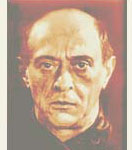Arnold Schoenberg
(1874-1951)
 Arnold Schoenberg’s name is nearly synonymous with the development of serial music in the twentieth century, but his works are more varied, being inspired by his life. Schoenberg was born in Vienna to Hungarian parents in 1874, and was raised in the Jewish orthodox faith. At age 8, Schoenberg began violin lessons, sparking a compositional spirit. He would imitate the music he was asked to learn and arrange familiar tunes for duos or trios to play with his friends.
Arnold Schoenberg’s name is nearly synonymous with the development of serial music in the twentieth century, but his works are more varied, being inspired by his life. Schoenberg was born in Vienna to Hungarian parents in 1874, and was raised in the Jewish orthodox faith. At age 8, Schoenberg began violin lessons, sparking a compositional spirit. He would imitate the music he was asked to learn and arrange familiar tunes for duos or trios to play with his friends.
The family was poor so the four children rarely heard music aside from what they could play themselves. After his father’s death, Schoenberg had to take a job at a bank, but he continued on his path as a self-taught musician and joined a small chamber group led by Zemlinsky, who would become a friend and teacher. In 1897, Zemlinsky offered Schoenberg’s string quartet to be performed in a concert held by the Wiener Tonkuenstlerverein. Following the premiere, subsequent performances of the music were not well received, leading Schoenberg on a path away from tonal harmony.
Schoenberg married Mathilde, Zemlinsky’s sister, in 1901 and the couple moved to Berlin, where he taught at the Stern Conservatory. When they returned to Vienna two years later, he continued teaching, both at a school and privately. Two of his notable students were Berg and Webern. Though society did not warmly welcome contemporary music, special committees formed to promote new music. One such group included Mahler, who supported Schoenberg after hearing his Verklaerte Nacht. As Schoenberg’s music became more dissonant, his life did as well. When he and his wife began painting lessons, it led to an affair between her and the instructor. Despite a growing curiousity in his music and an improving reputation, it became increasingly more difficult to find work. This did not stop him however, as there was a large output of music during this period and he became interested in conducting.
When World War I broke out and his students left, Schoenberg stopped teaching and decided to join the service in 1915 as a volunteer. By 1920, he was teaching again and giving seminars at the Schwarzwald School. This led to the creation of an organization which produced 117 concerts of modern music between 1919 and 1921. It was during this time that Schoenberg developed his serial composition process.
Schoenberg’s wife died in 1923 and one year later he remarried Gertrud Kolisch, moving the family to Berlin. Throughout the next decade, he taught at the Akademie der Kuenste where he experienced some relief from lifelong financial burdens and was given more freedom and flexibility, thus being able and inspired to compose more.
By 1933, the Anti-Semitic climate of the nation had trickled down to the academy and Schoenberg left the country. As a young man, he had become Lutheran and it was his faith that carried him through the war, but while the family spent the summer in France, he reconverted to the Jewish faith. They then moved to America when Schoenberg accepted a teaching post in Boston. His long-term health ailments became augmented and the family moved again to California, where he taught both privately and at the universities.
Though he became an American citizen in 1941, the country did not ease much stress as his relations back home were in jeopardy and there was little demand for his music in the states. Schoenberg’s health continued to decline from 1944 until his death, including a heart attack from which he was resuscitated in 1946. The support of his family and his faith helped him through this time, as is evidenced by the religious themes found in his latest compositions. He also managed to publish a compilation of essays and articles in his final years. Unfortunately, he did not experience great success during his life, but Schoenberg’s legacy lives on as a foundational composer of the serial movement and through his work in promoting innovative music.
Click below to view Arnold Schoenberg titles:
t7t3l0uhl8|0010C39D6D07|DetailContent|contenttext|2BE8B678-3072-45CB-86BA-68FDECA3C14A